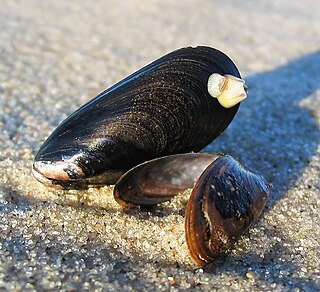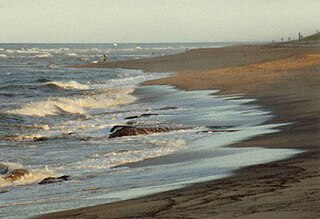
The Chesapeake Bay is an estuary in the U.S. states of Maryland and Virginia. The Bay is located in the Mid-Atlantic region and is primarily separated from the Atlantic Ocean by the Delmarva Peninsula with its mouth located between Cape Henry and Cape Charles. With its northern portion in Maryland and the southern part in Virginia, the Chesapeake Bay is a very important feature for the ecology and economy of those two states, as well as others. More than 150 major rivers and streams flow into the Bay's 64,299-square-mile (166,534 km2) drainage basin, which covers parts of six states and all of Washington, D.C.

Oyster is the common name for a number of different families of salt-water bivalve molluscs that live in marine or brackish habitats. In some species the valves are highly calcified, and many are somewhat irregular in shape. Many, but not all, oysters are in the superfamily Ostreoidea.

The eastern oyster —also called Wellfleet oyster, Atlantic oyster, Virginia oyster, or American oyster—is a species of true oyster native to the eastern seaboard and Gulf of Mexico coast of North America. It is also farmed in Puget Sound, Washington, where it is known as the Totten Inlet Virginica. Eastern oysters are and have been very popular commercially. Today, less than 1% of the original 17th-century population is thought to remain in the Chesapeake Bay and its tributaries, although population estimates from any era are uncertain. The eastern oyster is the state shellfish of Connecticut, its shell is the state shell of Virginia and Mississippi, and its shell in cabochon form is the state gem of Louisiana.

Oyster farming is an aquaculture practice in which oysters are raised for human consumption. Oyster farming was practiced by the ancient Romans as early as the 1st century BC on the Italian peninsula and later in Britain for export to Rome. The French oyster industry has relied on aquacultured oysters since the late 18th century.
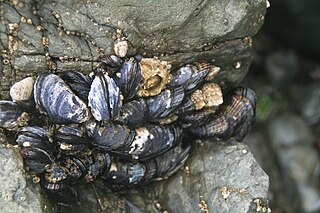
The California mussel is a large edible mussel, a marine bivalve mollusk in the family Mytilidae.

Urosalpinx cinerea, common name the eastern or Atlantic oyster drill, is a species of small predatory sea snail, a marine gastropod mollusk in the family Muricidae, the murexes or rock snails.

USS Jubilant (AM-255) was an Admirable-class minesweeper built for the United States Navy during World War II. She served in the Atlantic during World War II. She was decommissioned in May 1946 and placed in reserve. Although she did not see service in the war zone, Jubilant was recommissioned in May 1951 during the Korean War and remained in commission until April 1954, when she was placed in reserve again. While she remained in reserve, Jubilant was reclassified as MSF-255 in February 1955 but never reactivated. In October 1962, she was sold to the Mexican Navy and renamed ARM DM-01. In 1994 she was renamed ARM General Miguel Negrete (C50). She was stricken in 2000, and sunk as an artificial reef off Veracruz in August 2001.
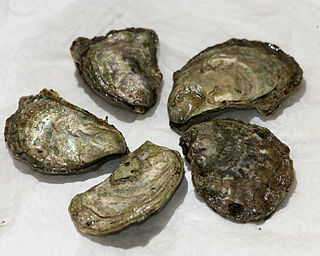
Ostrea lurida, common name the Olympia oyster, after Olympia, Washington in the Puget Sound area, is a species of edible oyster, a marine bivalve mollusk in the family Ostreidae. This species occurs on the northern Pacific coast of North America. Over the years the role of this edible species of oyster has been partly displaced by the cultivation of non-native edible oyster species.

Mytilopsis leucophaeata is a species of small bivalve mollusc in the false mussel family, Dreissenidae. It is commonly known as Conrad's false mussel or the dark false mussel.
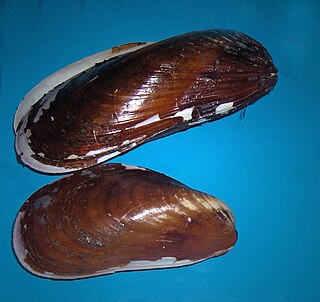
Modiolus modiolus, common name northern horsemussel, is a species of marine bivalve mollusk in the family Mytilidae.

The Mediterranean mussel is a species of bivalve, a marine mollusc in the family Mytilidae. It is an invasive species in many parts of the world, and also an object of aquaculture.
Geukensia demissa is a species of mussel, a marine bivalve mollusk in the family Mytilidae, the true mussels. This species is native to the Atlantic coast of North America. The common names for this species include ribbed mussel, Atlantic ribbed marsh mussel and ribbed horsemussel. However, the common name ribbed mussel is also used for the Southern Hemisphere mussel Aulacomya atra. The appearance of the shell is grooved and oval in shape. The interior of this mussel is tinted purple

Isognomon alatus, the flat tree oyster, is a species of bivalve mollusc in the family Isognomonidae. It can be found along the Atlantic coast of North America, ranging from southern Florida to Brazil and Bermuda.
Isognomon radiatus, Lister's tree oyster or the radial purse oyster, is a species of bivalve mollusc in the family Pteriidae. It can be found along the Atlantic coast of North America, ranging from southern Florida to Brazil and Bermuda.

Spondylus americanus, the Atlantic thorny oyster, is a species of bivalve mollusc. It can be found along the Atlantic coast of North America, ranging from North Carolina to Brazil.

Living shorelines are a relatively new approach for addressing shoreline erosion and protecting marsh areas. Unlike traditional structures such as bulkheads or seawalls that worsen erosion, living shorelines incorporate as many natural elements as possible which create more effective buffers in absorbing wave energy and protecting against shoreline erosion. The process of creating a living shoreline is referred to as soft engineering, which utilizes techniques that incorporate ecological principles in shoreline stabilization. The natural materials used in the construction of living shorelines create and maintain valuable habitats. Structural and organic materials commonly used in the construction of living shorelines include sand, wetland plants, sand fill, oyster reefs, submerged aquatic vegetation, stones and coir fiber logs.
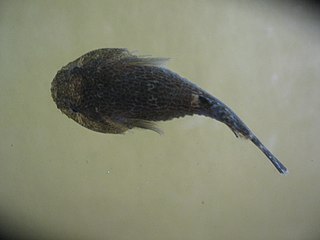
The skilletfish,, is a member of the family Gobiesocidae, composed of clingfishes. These are mainly marine, tropical and temperate fishes characterized by a powerful sucking disk on the underside of the forebody.

The term oyster reef refers to dense aggregations of oysters that form large colonial communities. Because oyster larvae need to settle on hard substrates, new oyster reefs may form on stone or other hard marine debris. Eventually the oyster reef will propagate by spat settling on the shells of older or nonliving oysters. The dense aggregations of oysters are often referred to as an oyster reef, oyster bed, oyster bank, oyster bottom, or oyster bar interchangeably. These terms are not well defined and often regionally restricted.

Clathria prolifera, commonly known as red beard sponge, is a species of demosponge in the family Microcionidae. It is native to shallow water habitats in the western Atlantic Ocean from Prince Edward Island southwards to Florida and Mexico, and possibly Brazil. In the twentieth century it also became established on the west coast of the United States.

